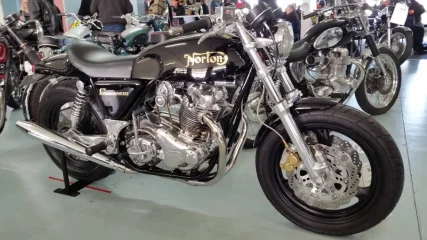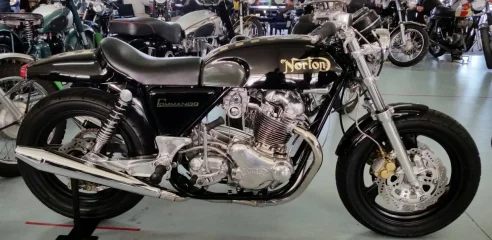Join the Access Norton Community
- Thanks for visiting Access Norton
- 3 free views left
- Create a free account (more details)
- Already a member? Click here to login
You are using an out of date browser. It may not display this or other websites correctly.
You should upgrade or use an alternative browser.
You should upgrade or use an alternative browser.
Drouin supercharger (2012)
- Thread starter baz
- Start date
- Status
- Not open for further replies.
- Joined
- Oct 19, 2005
- Messages
- 18,978
jimbo
VIP MEMBER
- Joined
- Sep 25, 2004
- Messages
- 2,071
Revisiting Drouins. Can someone direct me to a summery of the different Commando Drouin models? I have found a dual belt type that uses the stock outer primary cover with a hole in it. Is that one to be avoided over the others? Which is better, one belt or two?
jimbo
VIP MEMBER
- Joined
- Sep 25, 2004
- Messages
- 2,071
Can you explain? Looking at them it seems a toothed belt off the end of the crankshaft could be better because of a lower tension and less strain. What was the reason for a two belt system? Most of the time in a drive system it is to increase speeds with limited space or reduce stresses on the primary drive.The single belt is the best one
baz
VIP MEMBER
- Joined
- May 26, 2010
- Messages
- 8,560
The twin belt type does use a toothed belt from the crank,the secondary belt is thin and flat,I think this second belt causes most of the problems with alignment with the sheer speed the belt,also the bearings trying to cope with 40,000 rpm at the impeller and the bearings are no longer made,the lake fuel injector was the widowmaker with the flat slide hanging up through the suction caused by the supercharger,the single belt one seems better but I don't think you could run a toothed belt because of the small diameter of the pulley at the super charger end,but a lot has changed in 45 years there's probably better belts out there now,and large flatslide carburetor to replace the leaky fuel injector etc, cheers
- Joined
- Dec 28, 2008
- Messages
- 2,035
Besides complexity and bragging rights, what does the Drouin do to the engine's reliability? Do you get an exciting afternoon or can you stir the adrenaline pot a bit longer?
Fast Eddie
VIP MEMBER
- Joined
- Oct 4, 2013
- Messages
- 22,700
There’s a guy called Ray Coleman over on one of the Facebook groups - I haven’t seen him on here at all.
View attachment 3127
He’s built the best looking supercharged Commando I’ve seen - looks way more factory than the Drouin in my opinion, plus it’s off a modern car, so they’re cheap and you can still get parts.
View attachment 3128
That’s neat.
baz
VIP MEMBER
- Joined
- May 26, 2010
- Messages
- 8,560
yep i agree i have a twin belt drouin on the shelf its a beautiful ornament ,but an aisin 500 on the bench, but time,knee caps and money are all against me at the moment,plus three customers bikes cheersThere’s a guy called Ray Coleman over on one of the Facebook groups - I haven’t seen him on here at all.
View attachment 3127
He’s built the best looking supercharged Commando I’ve seen - looks way more factory than the Drouin in my opinion, plus it’s off a modern car, so they’re cheap and you can still get parts.
View attachment 3128
jimbo
VIP MEMBER
- Joined
- Sep 25, 2004
- Messages
- 2,071
The twin belt type does use a toothed belt from the crank,the secondary belt is thin and flat,I think this second belt causes most of the problems with alignment with the sheer speed the belt,also the bearings trying to cope with 40,000 rpm at the impeller and the bearings are no longer made,the lake fuel injector was the widowmaker with the flat slide hanging up through the suction caused by the supercharger,the single belt one seems better but I don't think you could run a toothed belt because of the small diameter of the pulley at the super charger end,but a lot has changed in 45 years there's probably better belts out there now,and large flatslide carburetor to replace the leaky fuel injector etc, cheers
The bearings should still see that rpm with a single belt? The seller did say the secondary flat belt slipped
baz
VIP MEMBER
- Joined
- May 26, 2010
- Messages
- 8,560
Yes the impeller bearing speed is the same from the twin belt to the single belt set up,I think I read they were rated for 20,000 rpm not 40,000 ,the single belt set up looks a better bet to me,it has crossed my mind to re make and extend the impeller shaft on my drouin and fit an external pulley driven by a single belt from the crank,I would also bore the housing out to take take some ceramic deep groove bearings,slap on a tm40 mik and ride off into the sunset!!!, Bruce MacGregor has a reliable single belt unit ,and Barry Huron has the twin belt unit sussed there's a bloke in Germany that has a reliable unit
- Joined
- Jul 8, 2011
- Messages
- 2,668
The bearings should still see that rpm with a single belt? The seller did say the secondary flat belt slipped
Correct on the turbine spindle bearings, same speed between single belt and double belt versions. The overall ratio was 7:1 so in theory, at an engine redline of 7,000 rpm the turbine would be attempting to reach 49,000 rpm. The flat belt on the two belt system was designed to slip; that's how you modulate peak boost. I never used a single belt system but from what I recall of seeing them, the had the same belt slip feature.
The flat slides that came with the Drouin were crude but workable if you recognized the slide and body were machined for a pull to close cable; something that was totally not mentioned in the Drouin instructions and yet totally necessary. Go ahead, ask me how I know.
I always thought the Drouin could have used some sort of intercooler.
Last edited:
- Joined
- Jul 8, 2011
- Messages
- 2,668
Besides complexity and bragging rights, what does the Drouin do to the engine's reliability? Do you get an exciting afternoon or can you stir the adrenaline pot a bit longer?
The engine stood up very well to the 10 psi boost. I ran it on and off for a couple of years. The heat was tremendous but the engine handled it very well. At the time, I was running Omega pistons and a cam which was not the best combination but no detonation and gobs of torque, all the way from right off idle to full speed. I believe this pulling clean right off of idle was attributed to two things:
1.) You had a bit of immediate boost, and
2.) All fuel went through the turbine and was heated which I am certain turned most all of the fuel to vapor (no fuel droplets).
Plugs would come out spotless. Piston crowns were spotless.
Bruce McGregor would be the person to talk to about longevity.
What I did not care for with the Drouin is that it spoiled the nimble feeling of the bike. I believe it was the gyro effect of that little impeller spinning at tens of thousands of rpm high and behind the engine. It had a nice whistle, a throaty heart thumping sound out of the pea shooters and was pretty much unbearable loud with open pipes.
As for stirring the adrenaline pot a bit longer; remember that note above about it must have a double pull throttle system. Now just visualize an 850 Commando with 10psi boost and a sticking throttle going into a chicane. Youthful indiscretions.
Last edited:
- Joined
- Oct 15, 2014
- Messages
- 3
Hi driving the blower of the timing side turns it backwards. So is driving the bottom rotor.the way they were designed to be mounted.There’s a guy called Ray Coleman over on one of the Facebook groups - I haven’t seen him on here at all.
View attachment 3127
He’s built the best looking supercharged Commando I’ve seen - looks way more factory than the Drouin in my opinion, plus it’s off a modern car, so they’re cheap and you can still get parts.
View attachment 3128
- Joined
- Jun 30, 2012
- Messages
- 14,923
Methanol fuel is a form of chemical supercharging and commando engines love it. - Less heat build-up and easier to get the jetting right. The downside is fuel economy, but when you build a bike the major objective should be functionality. The end use dictates the direct you take, otherwise you end up with a dog's breakfast. With my bike there is an historic racing class with suits it. The cut-off date for using methanol is 1972. 850 Commandos arrived in Australia in 1973. But who is arguing ?
- Status
- Not open for further replies.
Similar threads
- Discussion
- Replies
- 0
- Views
- 396
- Replies
- 51
- Views
- 7,680
- Replies
- 12
- Views
- 3,849
- Replies
- 24
- Views
- 3,141



